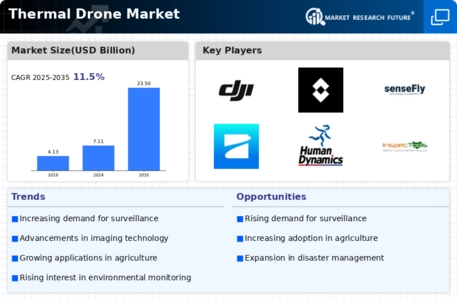Market Growth Projections
The Global Thermal Drone Market Industry exhibits promising growth projections, with anticipated market values reaching 7.11 USD Billion in 2024 and 23.5 USD Billion by 2035. This growth trajectory suggests a compound annual growth rate of 11.48% from 2025 to 2035, indicating robust demand across various sectors. The increasing adoption of thermal drones for applications such as surveillance, agriculture, and environmental monitoring is likely to drive this expansion. As technological advancements continue to enhance drone capabilities, the market is poised for significant evolution in the coming years.
Growing Adoption in Agriculture
The Global Thermal Drone Market Industry is witnessing a growing adoption of thermal drones in the agricultural sector. Farmers utilize these drones for crop monitoring, irrigation management, and pest detection, which enhances productivity and resource management. The ability to identify temperature variations in crops enables timely interventions, potentially leading to increased yields. As agricultural practices become more data-driven, the demand for thermal drones is likely to rise. This trend aligns with the broader movement towards precision agriculture, which is expected to contribute to a compound annual growth rate of 11.48% from 2025 to 2035.
Advancements in Drone Technology
Technological advancements play a pivotal role in shaping the Global Thermal Drone Market Industry. Innovations in sensor technology, battery life, and data processing capabilities have significantly enhanced the performance of thermal drones. For instance, the integration of high-resolution thermal cameras allows for more precise imaging and analysis. These advancements not only improve operational efficiency but also expand the range of applications, from agriculture to infrastructure inspection. As these technologies continue to evolve, they are expected to drive market growth, contributing to an anticipated market value of 23.5 USD Billion by 2035.
Regulatory Support and Frameworks
Regulatory support is emerging as a crucial driver for the Global Thermal Drone Market Industry. Governments worldwide are establishing frameworks that facilitate the safe integration of drones into various sectors. These regulations often include guidelines for commercial drone operations, which enhance public trust and encourage investment in drone technology. For instance, the Federal Aviation Administration in the United States has implemented rules that promote the use of drones for commercial purposes, including thermal imaging applications. This supportive regulatory environment is likely to foster market growth, as businesses increasingly leverage thermal drones for diverse applications.
Increasing Demand for Surveillance and Security
The Global Thermal Drone Market Industry experiences a notable surge in demand for surveillance and security applications. Thermal drones are increasingly utilized by law enforcement agencies and private security firms for monitoring large areas, detecting intrusions, and conducting search and rescue operations. This trend is driven by the need for enhanced safety measures in urban environments and critical infrastructure. The ability of thermal drones to operate in low-light conditions further amplifies their appeal. As a result, the market is projected to reach 7.11 USD Billion in 2024, reflecting a growing recognition of the value these technologies bring to public safety.
Environmental Monitoring and Disaster Management
The Global Thermal Drone Market Industry is significantly influenced by the increasing need for environmental monitoring and disaster management. Thermal drones are employed for assessing wildfires, monitoring climate change effects, and conducting search and rescue missions during natural disasters. Their ability to provide real-time data and imagery is invaluable for emergency responders and environmental agencies. As climate-related challenges become more pressing, the demand for thermal drones in these contexts is expected to rise. This trend underscores the potential for thermal drones to play a critical role in enhancing disaster preparedness and response strategies.










